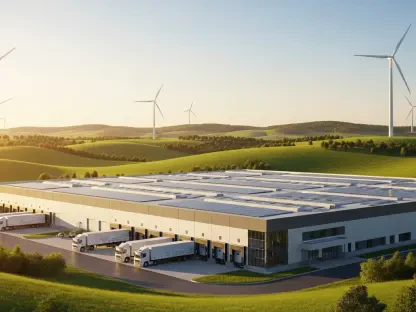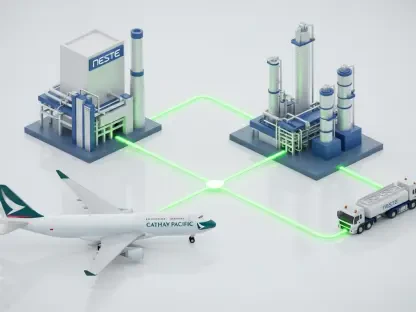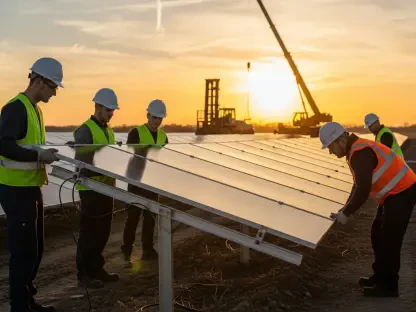Introduction to India’s Green Hydrogen Ambition
Imagine a future where India, a nation with vast industrial might, powers its refineries, steel plants, and cement factories with clean, sustainable energy, slashing carbon emissions on a global scale, while paving the way for a greener tomorrow. This vision is no longer a distant dream but a tangible goal, fueled by strategic partnerships in green hydrogen technology. A pivotal step in this journey is the recent collaboration between Greenzo Energy Limited and Engineers India Limited (EIL), focusing on the development of a Hydrogen Electrolyser Modular Unit. This partnership symbolizes a bold move toward indigenous innovation in clean energy solutions.
The initiative addresses critical challenges in scaling homegrown technologies to meet industrial demands. Reducing dependency on imported systems while aligning with decarbonization targets remains a steep hurdle for India. The collaboration aims to tackle these issues head-on, offering a blueprint for sustainable progress in key sectors that are notoriously hard to abate.
This development is not just about technical advancement but also about positioning India as a serious contender in the global clean energy race. By fostering such R&D efforts, the nation is laying the groundwork to transform its energy landscape, making green hydrogen a cornerstone of its environmental and economic strategy.
Background and Significance of Green Hydrogen in India
Green hydrogen, produced using renewable energy, holds immense promise for India’s sustainability ambitions under the National Green Hydrogen Mission. This policy framework seeks to establish the country as a leader in the production and export of this clean fuel, targeting significant capacity expansion over the coming years. Such aspirations are critical for reducing carbon footprints across heavy industries that form the backbone of the economy.
The importance of domestic innovation cannot be overstated, especially in sectors like steel and cement, where traditional processes are deeply carbon-intensive. Developing local solutions for green hydrogen production ensures not only environmental benefits but also energy security, reducing reliance on volatile international markets. This shift is vital for aligning with global climate commitments while maintaining industrial competitiveness.
Beyond immediate applications, this focus on green hydrogen ties into broader goals of energy self-reliance. As nations worldwide pivot toward cleaner alternatives, India’s ability to innovate and export sustainable technologies could redefine its role in the international energy market. This initiative with EIL and Greenzo Energy is a microcosm of that larger ambition, reflecting a commitment to both national and global environmental priorities.
Research Methodology, Findings, and Implications
Methodology
The R&D collaboration between Greenzo Energy Limited and Engineers India Limited was formalized through a meticulous process involving technical evaluation and selection. The contract, awarded via the Government e-Marketplace platform, underscores a transparent and rigorous approach to identifying capable partners for cutting-edge projects. This systematic selection highlights the trust placed in Greenzo Energy’s expertise in hydrogen technology.
The scope of this project includes the supply, installation, and ongoing support for a Hydrogen Electrolyser Modular Unit at EIL’s R&D Complex in Gurgaon, Haryana. This setup is designed to test and refine technologies that can be scaled for industrial applications. The detailed planning ensures that every phase, from design to deployment, adheres to high standards of innovation and reliability.
Findings
The successful securing of this contract by Greenzo Energy serves as a strong endorsement of its technical prowess in the emerging field of green hydrogen. This achievement is not merely a business win but a validation of the company’s ability to contribute meaningfully to national energy goals. It marks a significant milestone in demonstrating that domestic firms can lead in specialized clean tech domains.
Moreover, this partnership aligns seamlessly with the objectives of the National Green Hydrogen Mission. It showcases how targeted R&D can accelerate the adoption of sustainable practices in industries that are critical to India’s economic framework. The project’s outcomes are expected to provide valuable insights into the practical deployment of hydrogen technologies at scale.
Implications
This collaboration holds the potential to catalyze scalable decarbonization solutions across various sectors. By prioritizing indigenous technology, it reduces the need for foreign imports, fostering a self-sufficient ecosystem for green hydrogen production. Such advancements could reshape how energy-intensive industries operate, aligning them with stringent environmental standards.
Additionally, the success of this initiative may attract further investments and partnerships, both domestic and international. This could amplify India’s standing in the global hydrogen economy, positioning it as a hub for innovation and manufacturing. The ripple effects might extend to job creation and economic growth, reinforcing the strategic importance of such projects.
The broader impact lies in setting a precedent for public-private cooperation in clean energy. As more entities witness the tangible benefits of such alliances, the momentum for green hydrogen adoption could intensify, paving the way for systemic change in energy consumption patterns across the nation.
Reflection and Future Directions
Reflection
The milestone achieved through the partnership between Greenzo Energy and EIL reflects a growing confidence in domestic capabilities to address complex energy challenges. This collaboration is a testament to the potential of Indian firms to innovate in high-stakes areas like green hydrogen, earning trust from established public sector entities. It marks a moment of optimism for the sector’s trajectory.
Yet, scaling hydrogen technologies remains a formidable task. Solutions must not only be developed locally but also compete on a global stage in terms of cost and efficiency. This balance between innovation and practicality is a critical consideration for stakeholders aiming to transform ambitious policies into actionable outcomes.
The journey so far highlights the necessity of sustained commitment from both industry and government. While this project is a promising start, it also underscores the importance of continuous improvement and adaptation to meet evolving industrial and environmental needs.
Future Directions
Looking ahead, research and development should focus on enhancing the efficiency of green hydrogen production processes. Innovations that lower costs while maintaining high output are essential for widespread adoption, particularly in cost-sensitive markets. Exploring advanced materials and designs for electrolysers could be a key area of exploration.
Expanding collaborations between public institutions and private enterprises offers another avenue for progress. Such partnerships can pool resources, expertise, and infrastructure to tackle the multifaceted challenges of clean energy deployment. Creating frameworks for knowledge sharing and joint ventures could accelerate advancements in this space.
Finally, aligning R&D efforts with export ambitions is crucial for establishing India as a global leader. Developing technologies that meet international standards and cater to diverse markets will be vital. From 2025 to 2027, setting benchmarks for production capacity and cost reduction could position the nation at the forefront of the hydrogen economy.
Conclusion: India’s Path to Green Hydrogen Leadership
The partnership between Greenzo Energy Limited and Engineers India Limited stands as a foundational step in India’s journey toward a cleaner energy future. It highlights the critical role of indigenous innovation in meeting national decarbonization targets and showcases the potential for domestic companies to lead in specialized fields. This collaboration provides a model for how strategic alliances can drive progress in sustainable technology.
Moving forward, the focus shifts to actionable strategies that can amplify these early successes. Prioritizing investments in cutting-edge research, fostering more public-private partnerships, and establishing supportive policy frameworks emerge as essential next steps. These efforts aim to ensure that green hydrogen becomes a viable, mainstream solution for energy needs.
Additionally, addressing scalability challenges through targeted pilot projects and international cooperation offers a pathway to overcome existing barriers. By building on this momentum, India positions itself to not only meet domestic demands but also influence global clean energy trends, setting a benchmark for innovation and sustainability in the years that follow.









